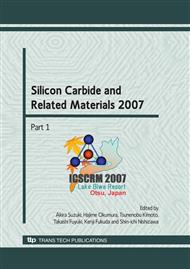p.675
p.679
p.683
p.687
p.691
p.695
p.699
p.703
p.707
High Channel Mobility of MOSFET Fabricated on 4H-SiC (11-20) Face Using Wet Annealing
Abstract:
We studied the annealing process to improve the field-effect channel mobility (μFE) on the 4H-SiC (11-20) face. We found that wet annealing, in which a wet atmosphere was maintained during the cooling-down period to 600°C after wet oxidation, was effective. The interface states (Dit) near the conduction band edge decreased and the μFE increased up to 244 cm2/Vs. Furthermore, the origin of this high channel mobility was investigated using secondary ion mass spectroscopy (SIMS) measurement and thermal desorption spectroscopy (TDS) analysis. It was indicated that the hydrogen density at the MOS interface was increased by the wet annealing and the hydrogen was desorbed mainly at temperatures between 800 °C and 900 °C. These hydrogen desorption temperatures also corresponded to the temperatures of the μFE reduction by argon annealing after the wet annealing. These results indicated that this high channel mobility was achieved by hydrogen passivation during the wet annealing at temperatures between 800 °C and 900 °C.
Info:
Periodical:
Pages:
691-694
Citation:
Online since:
September 2008
Authors:
Price:
Сopyright:
© 2009 Trans Tech Publications Ltd. All Rights Reserved
Share:
Citation:


